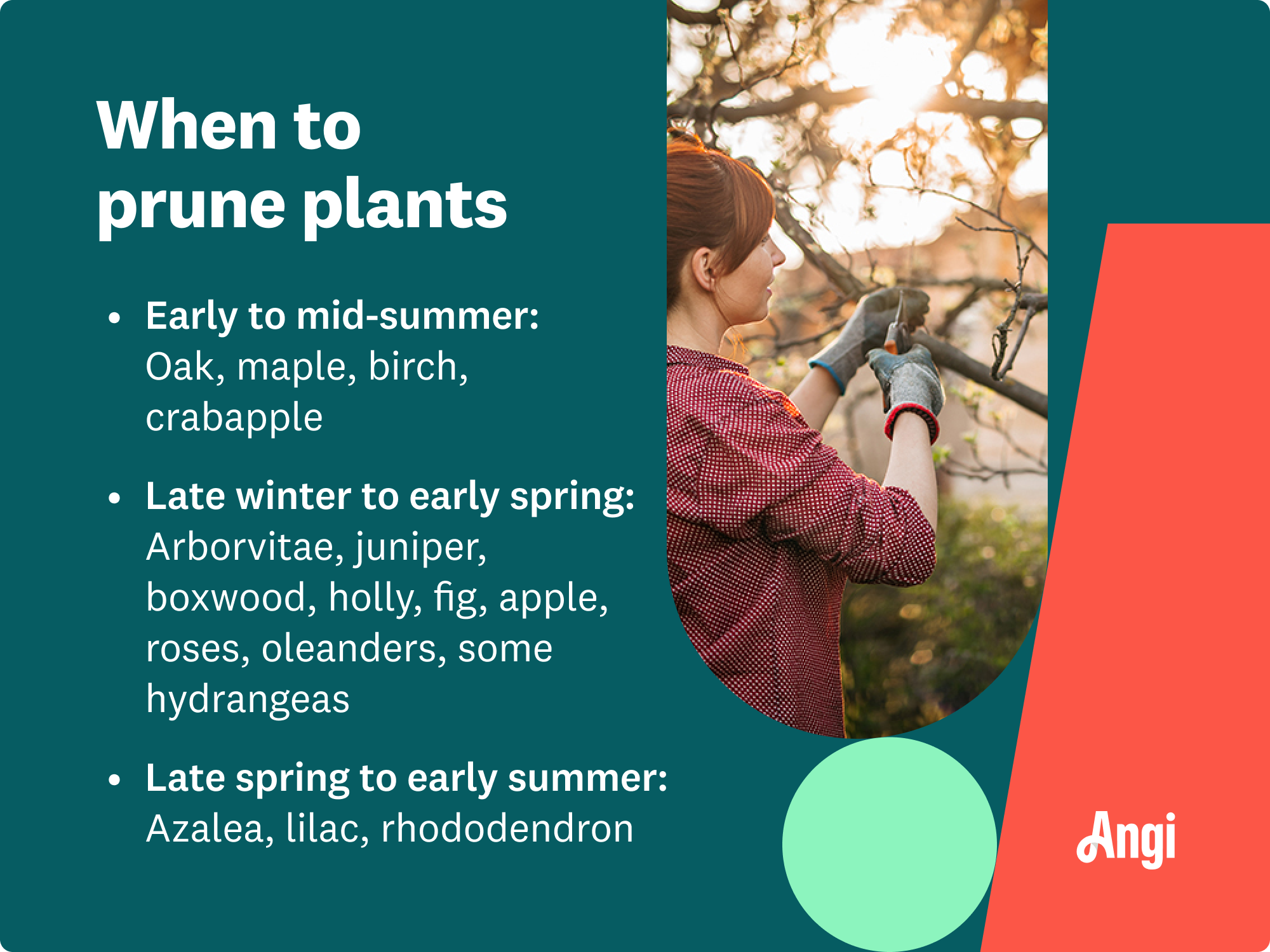
How much does hardscaping cost project by project? Check out our breakdown for every price tag you need to know, from outdoor fireplaces to patios.
Learn how to stay sharp with your plant pruning


Pruning can control growth and promote new flowers or fruits.
It’s important to remove dead and diseased branches ASAP.
Don’t remove more than 1/3 of the plant at a time.
Different plants and trees have different pruning schedules.
Avoid pruning in the fall and winter.
There are many occasions where plant caretaking involves pruning—whether it’s to redirect or control growth, remove dead or diseased portions, or promote flowering and fruiting.
The tricky part is knowing how and when to do it, as getting too snip-happy could potentially cause more harm than good. We’re here to cover pruning 101 and how to shape your pruning plan.
Pruning involves selectively removing the parts of a plant that stunt growth, aren’t nice to look at, or are detrimental to its overall health. Through this process, the plant owner can maintain and control growth, as well as encourage new blossoms or fruits when pruning trees. The right approach will vary depending on the type of plant, as well as the desired outcome.
It’s good pruning practice to keep an eye on your plants and nip whenever you see death or disease, rogue branches going off in an unwanted direction, or overgrowths that call for a haircut.
Whether it’s a type of ornamental grass or a houseplant, pruning 101 starts with having the right gear. A sharp, clean cut is essential for properly pruning your plants. Garden scissors can handle small branches and vines, while pruning shears are necessary for thicker branches (1/4 to 3/4 of an inch).
For pruning trees and larger shrubs, you’ll need a good pair of long-handled loppers, which can handle branches up to about 1 1/2 inches thick. For larger branches, a handsaw is the best tool.

It’s easy to get carried away with the pruning shears, especially when you’re trying to shape a plant to your liking. Don’t go too crazy, though, as removing too much from a plant at once can severely stress it out. This leaves it vulnerable to disease or even death, so it’s important to prune with caution.
As a general rule, never remove more than 1/3 of a plant’s growth at a time. The only exception here is cutting off dead or diseased portions—get rid of those ASAP.
To prevent a branch from growing longer, cut the bud at the tip of the shoot (also known as the terminal bud). The buds on the side of the branch are lateral buds, which cause the plant to bulk up or grow outward. Removing these will allow you to control the density of the plant.
If you are trimming back a dead or diseased branch, cut just before you reach the latent bud, which is a dormant bud that appears to be “hiding” beneath the surface. Anytime you make a cut, it should be about a quarter of an inch above a lateral bud at a 45-degree angle.
Most pruning is done when plants are just awakening from their slumber in late winter or early spring. Flowering shrubs are usually pruned after they bloom to ensure that the new blooms are not mistakenly pruned off. Fruit trees are pruned in early spring for greater yields.
Evergreens are the exception—these typically get pruned when they are dormant in the winter. Be extra careful not to over-prune, as branches often don’t grow back.
Follow these pruning 101 guidelines:
Deciduous trees (oak, maple, birch, crabapple): Late fall to winter
Evergreens (e.g. arborvitae, juniper, boxwood, holly): Late winter to early spring
Fruit trees (fig, apple): Late winter to early spring
Spring-flowering shrubs (azalea, lilac, rhododendron): Late spring to early summer
Summer-flowering shrubs (roses, butterfly bush, crape myrtle, spirea, oleanders, some hydrangeas): Late winter to early spring before buds emerge

Unless you’re removing dead, damaged, or diseased growth, avoid pruning in the fall. This can stimulate new growth that won’t have enough time to mature before the harsh winter hits. Damage or death due to frost is highly likely in this case.
If you’re not too plant savvy or simply don’t have the time to keep up with pruning your plants, consider hiring a gardener near you to keep your plants and trees thriving year-round.
From average costs to expert advice, get all the answers you need to get your job done.

How much does hardscaping cost project by project? Check out our breakdown for every price tag you need to know, from outdoor fireplaces to patios.

We break down the cost to remove bamboo, which is slightly higher than other forms of tree removal. It's a difficult DIY task because of bamboo's hardy underground roots.

The cost to remove a boulder depends on the size, location, and equipment needed. Learn the average boulder removal cost and how to save money on removal.

Wondering what’s the difference between artificial grass vs. turf and which one’s right for you? Get the pros and cons of each one here.

There are several ways to remove a lilac bush, including root removal and chemical intervention. Check out our guide to learn how to remove a lilac bush.

DIYing thorn bush removal is possible. This guide offers a list of necessary materials and a step-by-step walkthrough to help you remove thorn bushes.